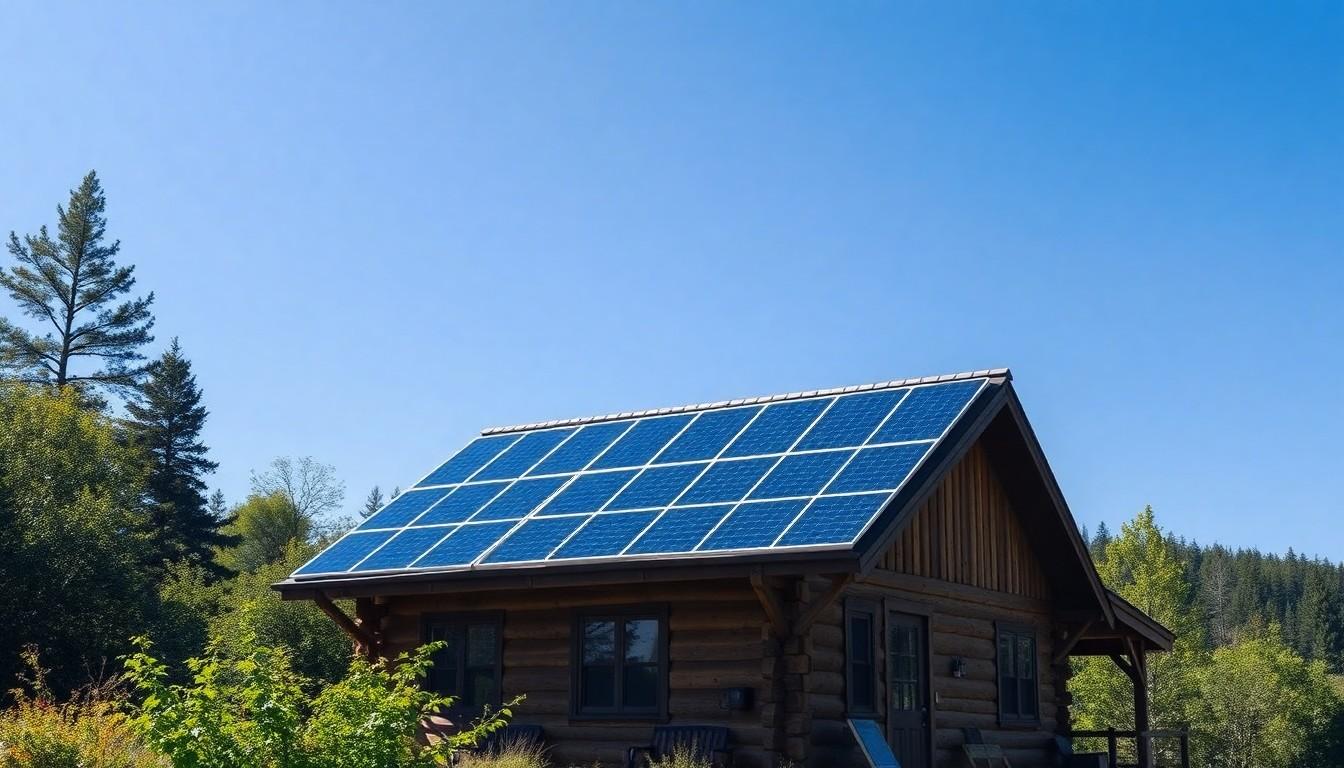Imagine sipping your morning coffee while basking in the glow of the sun, completely off the grid and free from utility bills. Sounds dreamy, right? With solar panels for off-grid living, that dream can become a reality. These shiny wonders harness the sun’s energy, turning those rays into power for everything from your fridge to your Wi-Fi router.
In a world where energy independence is the new black, solar panels offer a stylish solution to the age-old problem of rising energy costs. So why not trade in the chaos of city life for a serene retreat powered by the sun? Whether you’re a seasoned survivalist or just someone looking to escape the hustle, this guide will help you navigate the sunny side of off-grid living with confidence and a chuckle.
Solar Panels for Off Grid Living
Solar panels enable off-grid living by providing a reliable energy source independent of traditional electricity suppliers. These systems harness sunlight, converting it into usable power, which is essential for anyone looking to live outside the utility grid. Different types of solar panels, such as monocrystalline and polycrystalline, each offer unique efficiencies and costs, allowing individuals to choose based on their specific needs and budgets.
Energy storage solutions, like batteries, complement solar panels in off-grid systems. They store excess energy generated during sunny days for use during cloudy weather or nighttime. Proper sizing of both solar panels and batteries ensures consistent power availability, eliminating reliance on external energy sources.
Solar panels also contribute to eco-friendly living. By reducing fossil fuel dependency, they lower carbon footprints significantly. Many systems qualify for tax credits and rebates, enhancing the financial feasibility of installation. The technology continually evolves, leading to increasingly efficient panels and affordable battery options.
Maintenance requirements for solar panels are minimal, consisting mostly of keeping the panels clean and free from debris. Routine checks for system performance help ensure long-term functionality. The lifespan of quality solar panels often exceeds 25 years, solidifying them as a long-term investment.
Off-grid solar power provides versatility in application, from powering a single cabin to entire homesteads. Various setups can cater to different energy needs, making them an attractive option for both survivalists and individuals seeking a tranquil lifestyle. With careful planning and investment, anyone can enjoy the benefits of solar energy while embracing the freedom of off-grid living.
Benefits of Solar Panels for Off Grid Living

Solar panels provide numerous advantages for those embracing off-grid living. Energy independence becomes achievable, allowing individuals to reduce reliance on traditional power sources.
Environmental Impact
Utilizing solar panels significantly lowers greenhouse gas emissions. Fossil fuel consumption decreases, leading to improved air quality. Renewable energy sources like solar help protect ecosystems, preserving biodiversity. Many installations qualify for tax incentives, encouraging eco-friendly choices. Long-lasting solar technology results in less waste, benefiting the planet overall.
Financial Savings
Solar panels lead to substantial reductions in monthly energy expenses. Many homeowners avoid the high costs associated with conventional electricity. Initial investment pays off over time, providing long-term savings. Some individuals benefit from attractive government incentives and rebates, making solar adoption more affordable. Maintenance costs remain low, ensuring minimal financial strain as panels generate free energy.
Types of Solar Panels
Solar panels come in several types, each suited for different off-grid living needs. Understanding these options helps individuals make informed decisions for their energy requirements.
Monocrystalline Panels
Monocrystalline panels feature high efficiency, often exceeding 20%. These panels consist of a single silicon crystal structure, making them an excellent choice for limited space. They provide better performance in low-light conditions, allowing for consistent energy generation. Durability plays a significant role, as these panels typically have longer lifespans, often exceeding 25 years. While initial costs are higher, the long-term energy savings often justify the investment. People seeking greater energy independence frequently opt for monocrystalline panels due to their efficiency and reliability.
Polycrystalline Panels
Polycrystalline panels, made from multiple silicon crystals, deliver a slightly lower efficiency than their monocrystalline counterparts. Their efficiency usually ranges between 15% and 20%. These panels are often more affordable upfront, appealing to those on tighter budgets. They require slightly more space for installation, which can be a factor depending on available area. Despite their lower efficiency, polycrystalline panels perform well in warm temperatures, making them suitable for various climates. Individuals aiming for a balance between cost and efficiency often prefer these panels.
Thin-Film Panels
Thin-film panels represent a versatile option for off-grid living. They utilize a lightweight and flexible design, making installation easier on unconventional surfaces. While efficiency generally falls between 10% and 12%, they excel in low-light and high-temperature conditions. Their lower production costs contribute to affordability, but they require more space due to lower efficiency. Maintenance is minimal, and their lightweight nature reduces installation complications. Those seeking innovative solutions for diverse energy requirements find thin-film panels an attractive choice.
Important Considerations
When transitioning to off-grid living with solar panels, certain factors require careful evaluation. These considerations ensure energy independence and optimal usage of solar technology.
Energy Needs Assessment
Assessing energy needs remains crucial in planning an off-grid solar system. Identifying daily power consumption helps in selecting the right panel size and battery storage capacity. He or she may calculate energy use from appliances and devices, referring to wattages on product labels. Totaling these values reveals the overall inverter capacity required. Designing a system that accommodates future energy demands can prevent inadequacies as lifestyles evolve. Incorporating energy-efficient appliances also reduces total consumption, resulting in smaller solar systems.
Battery Storage Options
Battery storage options play a significant role in off-grid solar installations. Various types, such as lead-acid or lithium-ion batteries, impact costs and performance. Lithium-ion batteries, known for their longer lifespan and better energy density, may offer higher initial costs but provide superior efficiency over time. Comparatively, lead-acid batteries, while more affordable, often require more maintenance and have shorter lifespans. Systems should ensure adequate storage capacity for cloudy days or nighttime usage. Implementing smart energy management strategies helps maximize battery life and maintain consistent power supply.
Installation and Maintenance
Installing solar panels for off-grid living requires strategic planning. First, select an ideal location free from shade, maximizing sunlight exposure. Roof installations often use mounting brackets to secure panels, while ground-mounted systems should ensure stability. After determining the placement, connect the panels to an inverter, which converts direct current (DC) to alternating current (AC). This conversion allows households to use standard electrical devices effectively.
Maintenance of solar panels is straightforward. Regular cleaning prevents dust, bird droppings, or debris from obstructing sunlight and ensures optimal efficiency. Inspecting the system at least twice a year helps identify issues like loose connections or damaged panels early. Monitoring battery performance also plays a critical role in maintaining consistent energy supply. Lithium-ion batteries, although more expensive, often require less maintenance compared to lead-acid options.
System performance can be enhanced with smart energy management tools. These tools provide insights into energy production and consumption patterns, helping users optimize their usage. Having access to this data enables timely adjustments to the system, like recharging batteries during peak sunlight hours.
Finally, longevity is crucial. Solar panels typically have lifespans exceeding 25 years, but keeping them in optimal condition maximizes their effectiveness. Following manufacturer guidelines for regular checks and necessary replacements promotes long-term sustainability.




